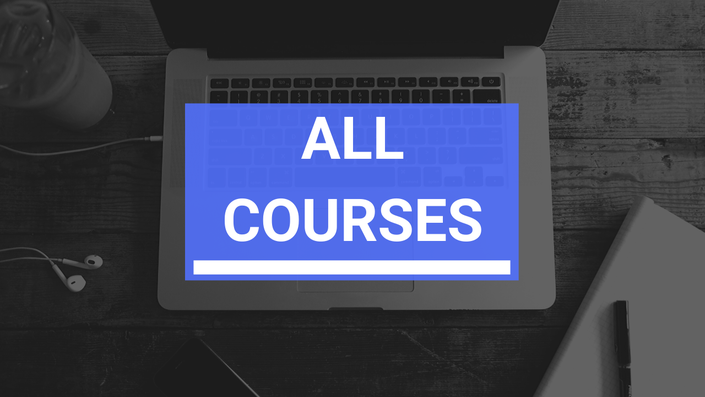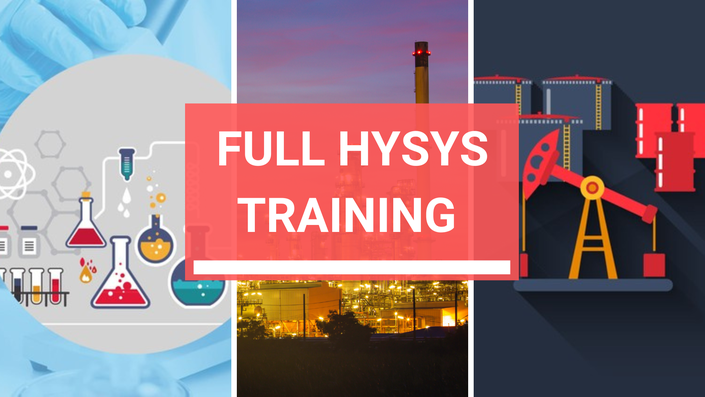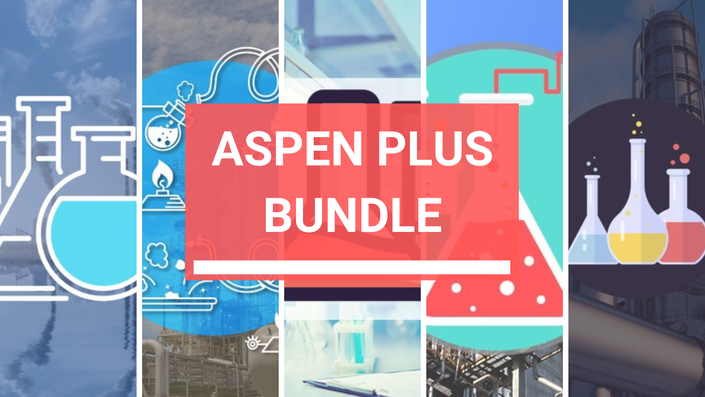Course Trailer
About this Course
📚 This focused course on Aspen Plus Physical Properties Environment teaches you how to select, configure, and manage thermodynamic models—one of the most critical steps in accurate process simulation.
You will work with key aspects of the Properties environment including:
- Component Selection
- Property Method Selection
- Thermodynamic Packages
- Data Regression
- Binary Interaction Parameters
- Property Estimation Tools
👨🏫 Designed for
Students, engineers, and professionals working in process simulation, design, or optimization where thermodynamics plays a central role.
📚 Course Approach
A clear, example-driven approach with hands-on case studies and practical explanations.
🎯 By the end of the course, you will be able to:
- Configure the Properties Environment in Aspen Plus
- Choose appropriate thermodynamic models based on system type
- Add and manage components and their interaction parameters
- Understand how model selection impacts results
- Use Aspen’s property estimation and databank tools effectively
🚀 Recommended for
Aspen Plus users who want to deepen their understanding of the thermodynamic foundations of simulation.
✅ You’ll learn to:
- Set up component lists for ideal and real systems
- Select and justify thermodynamic models like NRTL, Peng-Robinson, UNIFAC, and more
- Estimate missing physical property data
- Use group contribution methods and databank comparisons
- Handle electrolytes and non-conventional components
- Troubleshoot convergence and data errors related to properties

Self-Paced, Dynamic Lectures
Learn at your own pace, anytime and anywhere.
The lectures are concise, engaging, and focused—designed to maximize your understanding efficiently.

Downloadable Material
Get access to all simulation files, workshop materials, spreadsheets, reference guides and companion E-Book.
Use them to practice offline, follow along with lessons, or revisit concepts anytime.

Evaluations, Quizzes
Evaluate your progress through interactive quizzes and self-assessments.
Reinforce key concepts, identify gaps, and ensure you're ready to apply what you've learned in real scenarios.

30 Day Money-Back Warranty
Enroll with confidence—if the course doesn’t meet your expectations, you can request a full refund within 30 days.
No questions asked.

Certificate of Completion
Receive an official certificate or diploma once you finish the course—perfect for showcasing your new skills on your resume, LinkedIn, or job applications.

Instructor Support
Get guidance whenever you need it—ask questions, request feedback, and interact directly with the instructor throughout the course.
Example Curriculum
- Welcome (7:08)
- Introduction & Content Index (9:18)
- Course Objectives (5:24)
- Requirements & Recommendations (3:04)
- Benefits of the Course (2:06)
- Join the Aspen Plus & HYSYS Forum (Unofficial) (1:27)
- Resources & Downloads
- Quick Review - Aspen Plus (0:56)
- Physical Property Environment Overview (4:31)
- Physical Property - Setup Folder (1:43)
- Please be part of the discussion! (0:49)
- Free Water vs. Dirty Water (1:24)
- Workshop #001: Unit Set - Lab (3:43)
- I really appreciate this! (0:40)
- Component Specification Introduction (2:13)
- Component Specification - Introduction (0:22)
- Component Types (2:17)
- Do the workshops! (1:30)
- Workshop #002: Adding Existing Components (CONVENTIONAL) (2:28)
- Workshop #003: Adding Existing Components (SOLIDS) (1:52)
- Henry Component (2:15)
- Workshop #04: Adding Henry Components (1:24)
- Component Groups (2:13)
- Workshop #05: Creating a Component Group (3:02)
- Component Databases (8:31)
- Workshop #06: Selecting Databanks (4:00)
- Workshop #07: Database Search Order (2:12)
- Component Specification Closure (0:37)
- Property Methods Introduction (4:21)
- Property Methods - Introduction (3A) (1:08)
- Why Property Method? (4:13)
- Ideal vs. Nonideal Modeling (7:53)
- Ideal Models (2:34)
- Workshop #08: Method Selection - IDEAL (4:44)
- EOS vs Activity Models (4:13)
- Activity Coefficient Methods (6:45)
- Margules & Van Laar Activity Model (5:27)
- Wilson Activity Model (4:42)
- NRTL Activity Model (6:22)
- UNIQUAC Activity Model (2:40)
- UNIFAC Activity Model (3:12)
- Workshop #09: Method Selection - ACTIVITY COEFFICIENT (6:08)
- Equation of State Methods (4:18)
- Lee Kesler Pokler (LKP) - EOS Model
- Soave Redlich Kwong (SRK) - EOS Model (4:15)
- Peng Robinson (PR) - EOS Model (2:14)
- Workshop #10: Method Selection - EQUATION OF STATE (4:48)
- Special Property Methods (4:46)
- Workshop #11: Method Selection - SPECIAL (8:03)
- Effects of Method Selection (0:28)
- Workshop #12: Method Effects on Process Results (4:27)
- Property Method Selection Guides (7:25)
- Property Method Assistant (0:50)
- Selecting a Method by Component (1:02)
- Workshop #13 Method Assistant - Component Type (3:07)
- Selecting a Method by Process Type (1:28)
- Workshop #14: Method Assistant - Process Type (3:17)
- Modifying Property Methods (1:37)
- Workshop #15: Modifying Property Methods (2:14)
- 5 min break! (1:01)
- Introduction to Parameters (3B) (2:41)
- Retrieving and Clearing Parameters (1:35)
- Workshop #16: Pure Component Parameters (2:14)
- Binary Parameters (2:45)
- Workshop #17: Binary Component Parameters (2:35)
- Parameter Estimation with UNIFAC Model (3:12)
- Workshop #18: Estimation of missing Parameters via UNIFAC (3:21)
- Henry's Law Parameters (1:30)
- Workshop #19: Henry's Law Components (1:34)
- More on Binary Parameters (0:57)
- Introduction to Method Calculation & Routes (3C) (0:42)
- Method vs. Models (2:12)
- Model Properties (Physical) (2:35)
- Method Routes (3:03)
- Workshop #20: Viewing, Cloning, Modifying and Creating Method Routes (6:49)
- Workshop #21: Creating your own Method (8:15)
- Property Method Closure (1:10)
- Analysis Tools Introduction (5:16)
- Introduction to Analysis Tools (2:52)
- Pure Component (5A) (2:48)
- Workshop #24: Pure Component Analysis - Single Point (2:20)
- Workshop #25: Pure Component Analysis - Table Points (3:25)
- Workshop #26: Pure Component Analysis - Gibbs Free Energy (4:29)
- PT Envelopes (5B) (1:28)
- Workshop #27: PT Envelope for a Pure Substance (2:58)
- PT Envelopes for Mixtures (2:56)
- Merging Plots (1:25)
- Workshop #28: PT Envelopes for Mixtures (2:10)
- Binary (5C) (1:48)
- T-xy Diagrams (1:39)
- Workshop #29: T-xy Diagram (6:05)
- P-xy Diagrams (1:30)
- Workshop #30: P-xy Diagrams (4:11)
- Gibbs Free Energy Diagrams (1:09)
- Workshop #31: G-xy Diagrams (4:18)
- Mixture Analysis (5D) (2:31)
- Workshop #32: Mixture Analysis of a Pure Substance (2:52)
- Workshop #33: Mixture Analysis for Ethanol:Water Mix (1:52)
- Ternary Diagram (5E) (2:32)
- Ternary Diagrams - Azeotrope Search (3:21)
- Workshop #34: Binary Azeotrope Search via Ternary Diagram (2:12)
- Workshop #35: Binary Azeotrope Search via "Searh Azeotrope" Tool (2:24)
- Workshop #36: Ternary Azeotropes via Ternary Diagrams (1:57)
- Workshop #37: Ternary Azeotropes via "Search Azeotrope" Tool
- Residue Curves (5F) (2:19)
- Workshop #38: Residue Curves (Ethanol-Water-EthylAcetate) (3:22)
- More to come... (0:45)
- Analysis Tools Closure (0:59)
- Data & Regression Section Introduction (2:16)
- Data & Regression Introduction (1:41)
- NIST TDE Experimental Databases (7:48)
- Workshop #39: Retrieving Data form NIST TDE (PURE) (3:22)
- Workshop #40: Retrieving Data from NIST TDE (BINARY) (3:27)
- Saving Data from NIST TDE (1:15)
- Workshop #41: Saving Data from NIST (3:02)
- What is DeChema? (1:36)
- Workshop #42: Getting Data from DeChema (2:02)
- Data Input (2:17)
- TabPoly (1:54)
- Workshop #43: Input of Data via TabPoly (2:15)
- Regression Tool (1:48)
- Evaluation of Data via Regression (2:02)
- Workshop #44: Evaluation of VLE Data via Regression Tool (4:57)
- Regression of Data (2:17)
- Workshop #45: Regression of VLE Data (6:27)
- More to come... (0:41)
- Data & Regression Closure (0:31)
- Property Estimation Introduction (2:04)
- Property Estimation (3:44)
- User-Defined Component Wizard (1:59)
- User-Defined Component Wizard for NONCONVENTIONAL (1:42)
- Workshop #46: NC Props Filling for Coal (2:24)
- User-Defined Component Wizard for SOLIDS (1:08)
- User-Defined Component Wizard for CONVENTIONAL (0:23)
- Molecule Editor (1:33)
- Workshop #47: Using the Molecule Editor (3:36)
- Workshop #48:Importing Molecules Stearin (Molecule Editor) (2:22)
- Workshop #49: Benzamide Estimation via Chemical Structure (5:08)
- Property Estimation Closure (0:29)
- Applications Introduction (2:56)
- Introduction to several applications (1:23)
- Pure Component Applications (0:18)
- Workshop#51: Vanillin (3:36)
- Workshop #52: Ibuprofen Estimation via Chemical Structure & More Data (2:48)
- Workshop#53: VLE Data of Toluene (3:27)
- Workshop#54: G°liq=G°vap for Pentane (5:18)
- Workshop#55: Pure Benzene Props - NIST (3:45)
- Workshop#56: Testing for PR vs. IAPWS-95 (3:13)
- Workshop#57: Property Sets (Heat-X) (6:13)
- Workshop#58: Property Sets (Flash Drum) (5:17)
- Workshop#59: PT Envelope & Property Sets (3:38)
- Workshop#60: Vapor Pressure of Steam (3:48)
- Binary Mixture Applications (1:09)
- Workshop#61: Hexane-Octane Binary Diagrams (3:47)
- Workshop#62: Water-Ethanol Binary Diagrams (6:06)
- Workshop#63: Chloroform-Tetrahydrofuran (4:52)
- Workshop#64: Benzene-Ethanol Experimental (5:24)
- Workshop#65: Regression: Improving PR Method (11:12)
- Workshop#66: Toluene-Methanol Experimental (5:10)
- Workshop#67: Isopropanol-Ethyl Acetate Verifying Experimental VLE Data (6:24)
- Workshop#68: Calculation of K-Values (PR/SRK/NIST) (3:50)
- Workshop#69: Binary Azeotrope (4:14)
- Workshop#70: Regression - VLE Data (4:57)
- Workshop#71: Regression of Raw data (7:48)
- Workshop#72: Regression of Experimental Data for UNIQUAC (10:05)
- Workshop#73: Testing WILSON, NRTL, UNIQUAC Models for Experimental Data (7:24)
- Workshop#74: Verify NIST Data (C1-C2) (5:14)
- Workshop#75: Verify Dew/Bubble points (3:26)
- Ternary Mixture Introduction (0:32)
- Workshop#76: Graph Activity Coefficients (4:34)
- Workshop#77: Liquid-Liquid Model Comparison (WILSON, NRTL, UNIFAC) (3:43)
- Workshop#78: Cryogenic Applications (3:05)
- Workshop#79: Azeotrope Search (2:21)
- Workshop#80: Ternary Azeotrope Search (1:40)
- Applications Closure (0:57)
Course Enrollment
This and all other courses are available only via the All Courses - One Subscription Membership.

Hi, I’m Emmanuel Ortega,
a.k.a. the Chemical Engineering Guy!
With five years in the chemical industry, from petrochemical plant design to polyester textiles, I bring real-world experience to show the true value of engineering knowledge.
My Expertise:
- Process Simulation & Optimization
- Chemical Process Design
- Process Equipment Design
- Automotive & Industrial Polyester Yarn Technologies
- Online Tutoring, Online Education Management
The Courses I design are entirely dynamic. You will see theory and then apply it ASAP to a real life problem! I even use the books you are using right now in your engineering courses...
I'll see you in class!
Frequently Asked Questions (FAQ)
- When does the course start and finish?
- The course starts now and never ends! It is a completely self-paced online course - you decide when you start and when you finish.
- How long do I have access to the course?
- *How does lifetime access sound? After enrolling, you have unlimited access to this course for as long as you like - across any and all devices you own.
- NOTE*: This is true as long as you keep your subscription active.
- What if I am unhappy with the course?
- We would never want you to be unhappy! If you are unsatisfied with your purchase, contact us in the first 30 days and we will give you a full refund.
- Will I Get a Certificate/Diploma of Completion?
- Yes! After the course, you will get a Certificate of Completion with a Diploma! You can use this in your Resume!
- Are Resources Downloadable?
- Absolutely YES! Every resource is available for download, allowing you to study alongside them.
- Any doubt? Message me!
- Please reach out! [email protected]




